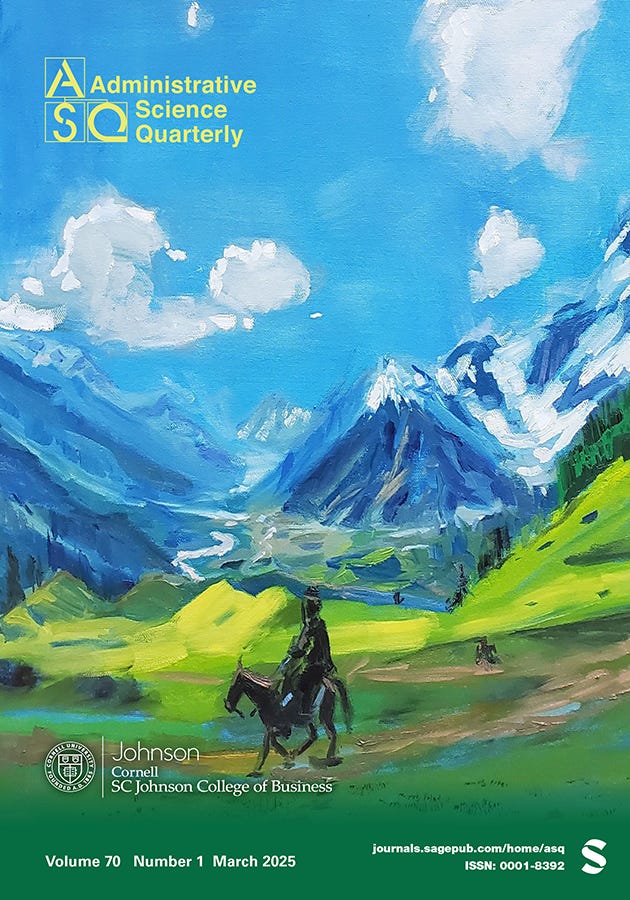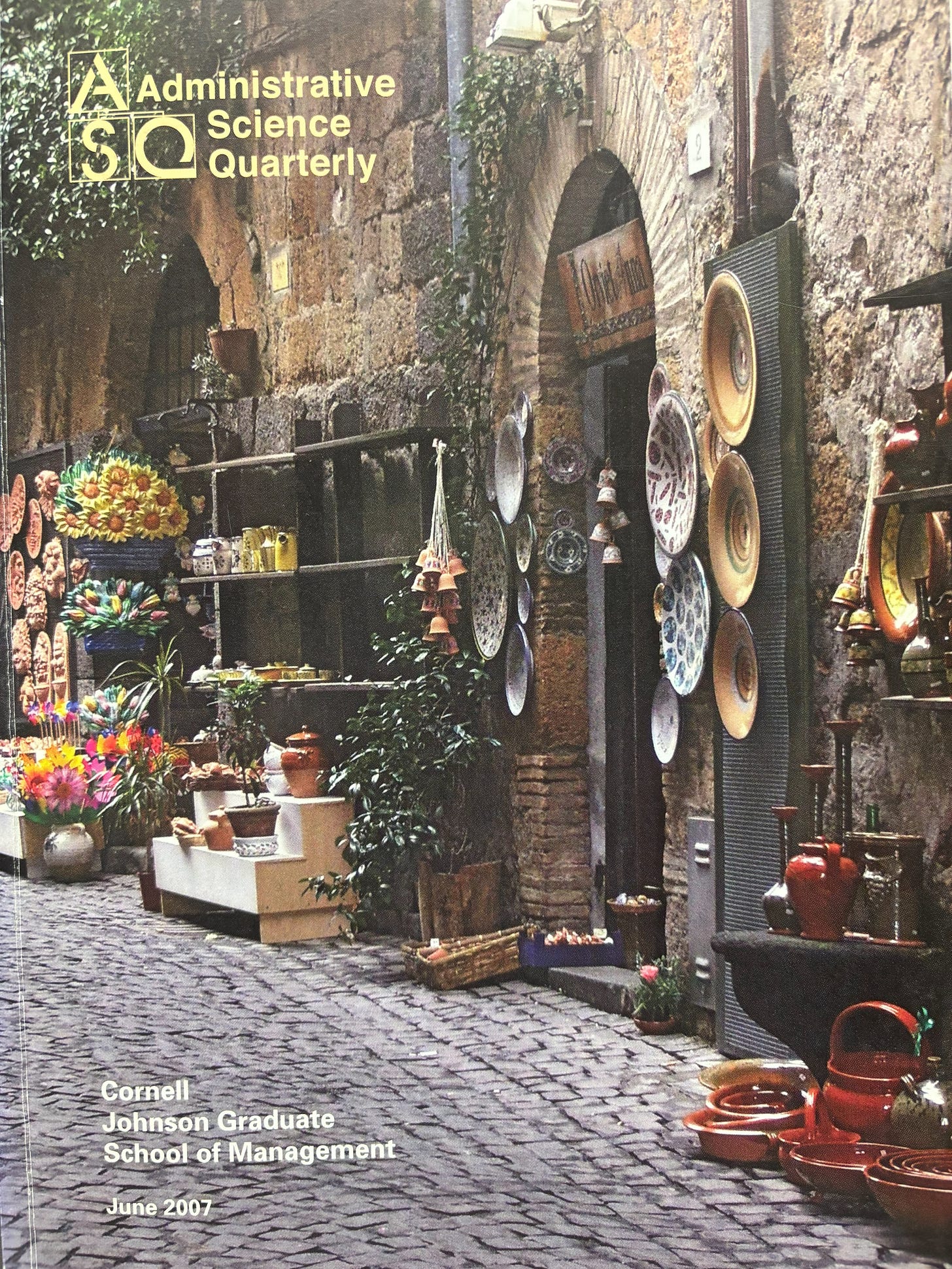Celebrating ASQ's 70th Year
An overview of the March 2025 issue and a reflection (and writing tips) by our Associate Managing Editor, Ashleigh Imus.
Introduction to the 70th Volume
We are celebrating the 70th volume of ASQ in 2025, and it is worth pausing to reflect on how far we have come. At our 50th anniversary, we were just moving to electronic submissions (yes, we used to use the postal service to share our work). To mark the occasion, we have added a bonus essay in every issue this year—highlighting current challenges and offering reflections on where we might turn our attention. You can find some reflection on ASQ’s history and details of the upcoming essays in my letter from the editor (as well as in the first essay, by Bechky and Davis, in this issue).
March 2025 Issue
The empirical articles in this timely issue speak to stigmatization in an authoritarian regime, an occupation’s demise as university goals of recycling broadened to sustainability, the persistence of organizational imprints in the face of disruption, and the challenges of relationships—in clients obtaining trustworthy and expert opinions from doctors, in incorporating the interests of beneficiaries in an organization’s social impact initiatives, and in managing perceptions of competition in interorganizational collaborations. And don’t forget the book reviews: These are wonderful ways to learn about a range of topics, and they are often exceptionally enjoyable to read. Ashleigh uses a recent book review as an example of great writing in her post, “Sitting in your Reader’s Chair,” see below in this newsletter!
Resisting the Algorithmic Management of Science: Craft and Community After Generative AI
Beth A. Bechky and Gerald F. Davis
Online publication dramatically reduced publishing costs and has increased both the quantity and quantification of publications. In this essay honoring ASQ’s 70th year of publication, Bechky and Davis outline the negative effects of the algorithmic management of science, from the warping of the journal impact factor as a meaningful metric to the potential for AI to entirely automate knowledge production in the social sciences. The authors explore how organizational scholarship can be revitalized through reinforcing deep intellectual engagement in our craft and reinforcing core processes in both tenure and journal reviews to uphold our community.
Wasted? The Downstream Effects of Social Movement–Backed Occupations
Grace Augustine, Leanne Hedberg, Tae-Ung Choi, and Michael Lounsbury
How is it possible that actors bring positive, movement-backed change to their organizations but lose their jobs in the process? Through an analysis of 25 years of online conversations, this article investigates how recycling coordinators embedded recycling in their higher education institutions and yet, in doing so, eventually experienced occupational demise. The authors show how coordinators successfully institutionalized, operationalized, and provided a financial justification for recycling, with the dynamics of these strategies ultimately undermining the expansion of jurisdiction for their occupation.
Stigmatization by an Authoritarian Government: Russian NGOs Under the 2012 Foreign Agents Law
Anastasiya Zavyalova
How are new forms of stigma created? In an illustrative study of the 2012 Russian foreign agents law, Zavyalova shows how the Russian government used this law in a top-down process of stigmatization, increasingly targeting long-standing organizations and, eventually, the media and individuals. The author develops a model of stigmatization, demonstrating how the authoritarian government created a new form of stigma and broadened the suppression of select organizations and individuals. As organizations attempted to cope in a variety of ways, Zavyalova reveals the unfolding dynamics by highlighting the slow international response and lagged media coverage.
Mechanisms of Organizational Imprinting: From Entrepreneur to Organization
Markus C. Becker
This article conducts a longitudinal case study of Zeiss, a German manufacturer of optical instruments, to investigate how entrepreneurs imprint organizations. Spanning nearly 150 years and focusing on the firm’s founder and business partner, Becker shows that the founders’ early decisions, teaching, role modeling, and formalized rules left structural, behavioral, and product imprints that persisted in the face of extreme disruptions. This process study advances organizational imprinting research by identifying mechanisms of imprinting and by elaborating micro-level theories of imprinting by individuals.
Referral Triads
Mathijs de Vaan and Toby Stuart
What are the benefits of a referral from a trusted source? Third-party referrals facilitate client‒expert matches and can generate post-match trust, but this article finds a potential tension in these dynamics. Leveraging medical claims data, the authors show that patients have confidence in referrals to specialists initiated by their primary care physicians. Yet, strong ties between the physician and the specialist can diminish the quality of the match between the patient’s condition and the specialist’s expertise. This results in worse outcomes for patients. The study’s findings thus offer a rare window into the quality of brokered matches.
Competition in Collaboration: The Problem of (Mis)Aligned Perception
Sruthi Thatchenkery and Henning Piezunka
Why does competitive tension—a common, well-understood issue—continue to derail interorganizational collaborations? Focusing on the U.S. software industry, the authors find that perception is key: When only one firm perceives the other as a competitor, it leads to misaligned perceptions, differing expectations about behavior and performance, and subsequent failure. The article highlights the importance of perceptual alignment in developing effective collaborations and explores how different types of triadic relationships can mitigate the negative impact of misalignment.
Harambee! A Triadic Perspective on Social Impact: Organizations, Evaluators, and Target Beneficiaries in Kenya
Anna Kim
The beneficiaries of social impact actions are often seen as passive recipients of organizational efforts. Bringing the perspective of beneficiaries to explain the organization‒evaluator‒beneficiary triad, Kim studies the conditions supporting a corporate social responsibility project in Kenya. The author shows how target beneficiaries obtained needed leverage with the organization by corroborating the organization’s stated outcomes to evaluators. Beneficiaries then redirected the organization’s off-the-shelf practices preferred by the organization‒evaluator dyad toward more contextual practices that upheld their own goals and objectives.
Book Reviews
Michel Anteby. The Interloper: Lessons from Resistance in the Field
Tammar B. Zilber
Christina Lubinski. Navigating Nationalism in Global Enterprise: A Century of Indo-German Business Relations
Stephanie Decker
Dovev Lavie. The Cooperative Economy: A Solution to Societal Grand Challenges
Gerard George
Michèle Lamont. Seeing Others: How Recognition Works—and How It Can Heal a Divided World
Brandy Aven
Peter H. Kim. How Trust Works: The Science of How Relationships Are Built, Broken, and Repaired
Oliver Schilke
William S. Harvey. Reputations at Stake
Donald Lange
Sitting in Your Reader’s Chair… in 2025
By Ashleigh Imus (Associate Managing Editor, ASQ)
In 2007, former ASQ managing editor Linda Johanson wrote a short essay, “Sitting in Your Reader’s Chair: Attending to Your Academic Sensemakers,” which offers eight hints for helping writers think about “how their readers will make sense of what they’ve written” (p. 292). Those who haven’t read this essay will benefit from doing so: It’s extraordinarily well written, incisive, and offers great advice in just a few pages—like the point that readers will start to supply their own answers and definitions to unanswered questions (“If an answer is not offered quickly, readers are likely to supply a sort of provisional answer from their own stock of knowledge,” p. 292). This can get writers into trouble with their readers.
Now, in 2025, I wonder how the task of sitting in your reader’s chair might have changed since the essay’s publication. In 2007, the iPhone was first released, Facebook and Twitter were not yet household names, and Instagram and TikTok didn’t exist.
Now, with more information available than ever before and an unprecedented capacity to connect with others, many people struggle just to pay attention and—paradoxically—to empathize with those who hold different views. The refusal to empathize has now taken a dangerous political turn: As I write, the U.S. Centers for Disease Control has been ordered to “withdraw all papers involving its researchers that are being considered for publication by external scientific journals” so that the current U.S. administration can review them, presumably to enact censorship.
In this context, the idea of sitting in your reader’s chair becomes a radical act, an assertion of our humanity, and a capacity that we can no longer take for granted.
To sit in your reader’s chair is essentially a request for empathy because it involves understanding the “feelings, thoughts, and experience of another.” But we can’t truly know others’ thoughts and experiences, so we must imagine it. And this means that to try to empathize is not a technical task or a problem of knowledge. It’s an act that requires use of our imagination.
How can we imagine readers’ perspectives when so much—information overload, impersonal platforms that incite conflict, political directives—taxes our attention and energy and seems to diminish our imaginative capacity? Are we capable of this sort of empathizing in 2025? Is empathy dead?
One of the privileges of editorial practice is that doing quality work requires slowing down—way down. And when we do, we start to notice things. Recently I found that Roy Suddaby’s stellar review of Stewart Clegg’s Frameworks of Power, second edition, has much to teach writers.
This review, to me, presents a master class in how to sit in your reader’s chair. In the form, content, and method of his writing, Suddaby demonstrates the kind of empathy that is deeply generous to readers, inviting them in and holding their attention.
Let’s start at the sentence level. Suddaby does something very simple but that most academic writers don’t do: He varies the length of his sentences, alternating short and long clauses:
Previous efforts to explicate power in organizations have largely failed because of a tendency to treat theory as a singular ideological commitment. Clegg takes a different approach. He mobilizes a range of prominent theorists—Machiavelli, Lukes, Weber, Durkheim, Giddens, Foucault, and many more—in a classic model of scholarship that seeks understanding and integration rather than mere prediction.
Why does this work so well? Because it creates a reading experience that is both manageable and enjoyable. Academic writers often pile one long sentence after another, which quickly becomes exhausting and dull to read. Short sentences give readers a cognitive break by slowing down the reading, and they highlight key ideas, such as in the quote above when Suddaby writes “Clegg takes a different approach.” Writers who want to immediately improve their writing style can do so simply by varying sentence length.
This review also shows consideration for readers by providing context. Rather than assuming familiarity with Clegg’s first edition, Suddaby provides an overview so that all readers can understand his arguments about the strengths of the second edition. Those arguments focus on the importance of history as what he calls a “fourth frame of power” in Clegg’s second edition.
What’s also so interesting is how Suddaby enacts in his writing the very thing he is calling for. He doesn’t just urge scholars to use history and literature to expose the presence of deeply embedded power in organizations; he demonstrates the practice in his writing: “Contemporary organizations, particularly the modern corporation, exemplify power today in the same way that monarchies exemplified power in the feudal era and the Church exemplified power in medieval times in the West.”
He also crosses disciplines by invoking philosopher Michel Foucault (following Clegg) but also thinkers like the great twentieth-century philologist and literary critic Eric Auerbach. In other words, Suddaby doesn’t just tell scholars what to do. He shows them how to do it.
In these times of unprecedented upheaval, I believe we must decide to notice that empathy is alive. It’s still with us in the sentences of the many excellent thinkers who populate ASQ’s pages and elsewhere. In Suddaby’s case, I believe it’s no accident that his advocacy of history—the humanities discipline rooted in unearthing the perspectives of others—figures so centrally in his deeply empathetic writing.
In 2025 we can still discover how to sit in readers’ chairs—if we’re willing to slow down a bit and notice the fine examples all around us.
Our student-run ASQ Blog features interviews with ASQ authors that offer insights into the research and writing process. Check out these three recent posts!
Jinfeng “Phoenix” Chen (Purdue University) and Mac Strachan (Washington University in Saint Louis) interview James Chu (Columbia University).
Clara Soo (Michigan State University) and Drew Jauron (Tippie College of Business, University of Iowa) interview Winnie Yun Jiang (INSEAD) and
Amy Wrzesniewski (Wharton School of the University of Pennsylvania)
Xiaoxia Zhu (Salisbury University) and Daniya Kamran-Morley (University of Pittsburgh) interview Shoshana R. Dobrow (London School of Economics and Political Science), Hannah Weisman (Harvard Business School), Daniel Heller (Tel Aviv University), and Jennifer Tosti-Kharas (Babson College)
To stay informed, follow us on LinkedIn and subscribe to our newsletter on Substack for all the latest ASQ announcements and information.
Christine Beckman, University of California, Santa Barbara









I have a new Tapology of leadership based on Blake and Mouton’s five forms. Mine is nine forms five of which are free forms and for our controlling form. How do I submit it to ASQ for publication?